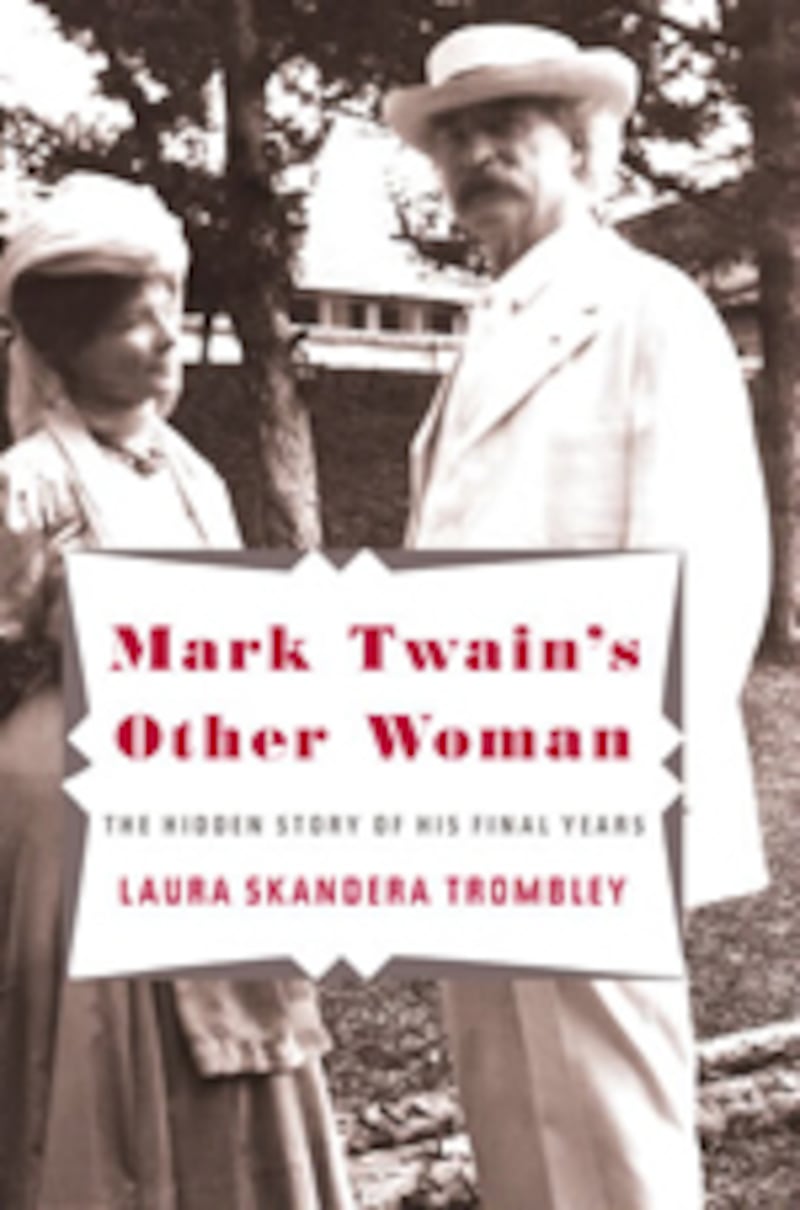
Carefully coiffed and couture'd, celebrities strode the Oscar red carpet two weeks ago. A few moments to preen and promenade for the cameras following months of planning and fitting, hours of hair and makeup.
This parade would be have been enjoyed and applauded by Mark Twain. While the author of The Adventures of Huckleberry Finn is not remembered as a fashionista or a film star, Twain certainly thought he possessed recherché taste and expended considerable effort and expense in cultivating his fashion-forward look. He wisely recognized early on: "Clothes make the man. Naked people have little or no influence on society."
An entire specialized area of business and copyright law has emerged from Twain's efforts and celebrities like J Lo, Jessica Simpson, and Victoria Beckham should give him a grateful nod.
Like any cutting-edge trendsetter, Twain soon realized that his ensembles might not always please the pedestrian audience. He received a terrible critique in 1872, at age 37, when he visited his great friend Thomas Bailey Aldrich in Boston. Entering Aldrich's elegant home for what he thought would be an enjoyable afternoon of swapping stories and drinking copious amounts of whiskey, Twain encountered Aldrich's wife: the humorless Lillian. Twain's sealskin coat, with the fur worn outward, offended her refined Brahmin, New England taste, as did his sealskin hat, pulled down over his ears. His dove gray waistcoat matched his jacket and Lillian decided his trousers were a hideous shade of yellowish-brown. Twain's sartorial splendor was topped off with a snappy violet bow tie.
Lillian assumed that Twain had to be drunk to be dressed in such a bizarre fashion and this suspicion was reinforced when she heard him speak in his strong Missouri accent. (Apparently she had never before heard a Southerner speak.) Despite being invited to dinner by his friend Aldrich, Lillian refused to move into the dining room. Twain, stung to the quick, left as soon as he could. He hated Lillian for the slight for the rest of his life. Lesson learned? Fashion hurts.

The apogee of all this dressing came on December 23, 1908, when he formed The Mark Twain Corporation. First, he incorporated his nom de plume in order to protect the copyright on his books and extend his royalties. Twain, however, was interested in much more than just protecting the copyright on his publications. Second, he copyrighted his image. Newspapers commonly called him the "most advertised man in the world" and he wanted to make money. Twain was the first important author-celebrity immediately recognizable worldwide with a resoundingly positive popular association. Since the beginning of his writing career, his pen name and face had been frequently used to sell products without his permission and without remuneration. During his lifetime the image and pseudonym Mark Twain sold playing cards, Oldsmobile cars, Pullman train passenger cars, baking flour, jumping frog mechanical banks, scrapbooks, photograph albums, cookbooks, postcards, sewing machines, shaving soap, fine china, decorative silver spoons and, of course, whiskey and cigars. Once he copyrighted himself, he became an official commodity and possessed the right to control the usage of his likeness as well as the right to sue those who would use it without compensating him. An entire specialized area of business and copyright law has emerged from Twain's efforts and celebrities like J Lo, Jessica Simpson, and Victoria Beckham should give him a grateful nod for creating the outlet that allows them to earn royalties from their clothing lines. What would Twain's reaction be to the flood of celebrity products? He would probably suffer a tinge of regret that he never thought to market his look.
While Twain loved to be colorfully garbed, he began experimenting with wearing all white as early as the 1870s. He ordered a suit of white flannel to wear while summering in the Adirondacks in 1890. His defining moment came in the fall of 1906, when he declared to his secretary that he had decided to defy "conventionalities and wear his suitable white clothes all winter." Twain adopted the pale shade full-time and by the end of his life in 1909, his wardrobe swelled with a total of 24 of the woolen wonders. When he visited his good friend Henry Rogers, the Standard Oil baron, he would insist upon taking six suits with him and would change at the slightest scuff. No one would outshine this peacock.
He found New York City a welcoming place for his efforts, and while the white suit attracted satisfying amounts of attention from the press and the public, Twain was determined to up the ante. To that effect, he added scarlet stockings to his ensemble and to top off his look he enjoyed wearing either a black or white cape, instructing his secretary to always hold it at the ready in case he might need it spread "on a mossy bank or a stone."
He was enormously proud of his full head of hair, appointing one of his maids to be his official stylist. Her efforts were so successful that the newspapers referred to Twain's locks as a "chrysanthemum of white hair." On one occasion after dressing up in his favorite outfit, Twain prepared to take a stroll down Fifth Avenue. His biographer objected on account that Twain would be recognized and mobbed. Twain, probably rolling his eyes, responded that this was exactly his intention. A little attention never hurts.
Twain's red-carpet moment occurred when he appeared before Congress on December 8, 1906, to advocate copyright law. While paying due attention to copyright and stating his desire to collect royalties ad infinitum, he ended up talking about his looks:
"Why don't you ask why I am wearing such apparently unseasonable cloths? I'll tell you. I have found that when a man reaches the advanced age of 71 years as I have, the continual sight of dark clothing is likely to have a depressing effect upon him. Light-colored clothing is more pleasing to the eye and enlivens the spirit. Now, of course, I cannot compel everyone to wear such clothing just for my especial benefit, so I do the next best thing and wear it myself. Of course, before a man reaches my years, the fear of criticism might prevent him from indulging his fancy. I am not afraid of that. I am decidedly for pleasing color combinations in dress. I like to see the women's clothes, say, at the opera. What can be more depressing than the somber black which custom requires men to wear upon state occasions. A group of men in evening clothes looks like a flock of crows, and is just about as inspiring." Twain's longtime friend William Dean Howells well-remembered the moment when he unveiled his white suit at the hearing: "Nothing could have been more dramatic than the gesture with which he flung off his long loose overcoat, and stood forth in white from his feet to the crown of his silvery head."
Twain's sartorial glory did not come without ample cost. His tailored suits cost upward of $60 to make (in today's dollars, approximately $1,300) and the upkeep that such a style demanded was expensive. But beauty is not cheap. Of course all this attention to his appearance meant that newspapers could not print enough photographs of him and the public was regularly treated to shots of Twain posing at various society events in white-suited glory with his cloud of hair carefully fluffed. This calculated theatrical effect enchanted the public, with one observer calling Twain's look "very soigné."
We all owe a debt of gratitude to Twain for being America's greatest writer; Ernest Hemingway got it exactly right when he commented: "All modern American literature comes from one book by Mark Twain called Huckleberry Finn." He should also be recognized for enthusiastically participating in a new medium, film, making his screen debut in 1909 when he was featured in a short black and white shot by Thomas Edison (now available for all to see on YouTube). Finally, he should also be saluted for his willingness to push the boundaries of men's wear. Twain would have loved the pomp and self-importance of Oscar night and would have insisted on being the first celebrity to strut in front of the screaming crowds. After all, Twain realized the power of the red carpet and owned the image of himself.
Plus: Check out Book Beast, for more news on hot titles and authors and excerpts from the latest books.
Laura Skandera Trombley is most recently the author of Mark Twain's Other Woman: The Hidden Story of His Final Years. She was raised in Southern California and attended Pepperdine University, where she earned her BA and MA, and the University of Southern California, where she earned a Ph.D. in English literature. She is the president of Pitzer College in Claremont, California. She lives in Claremont with her husband and son.






